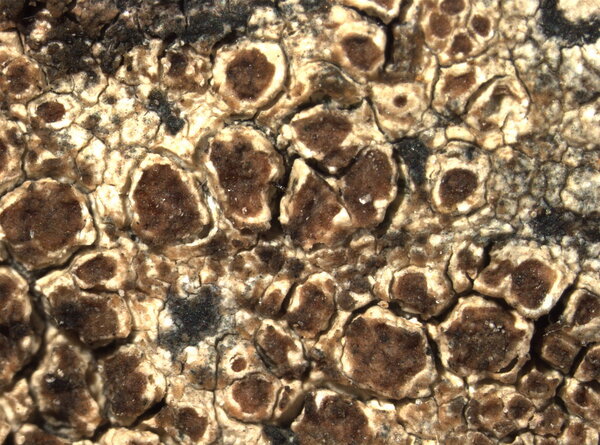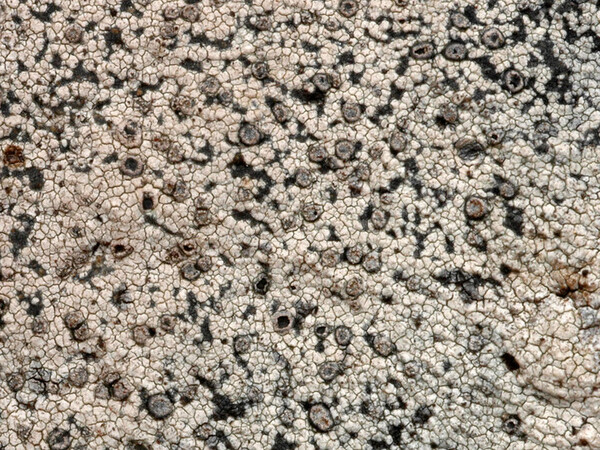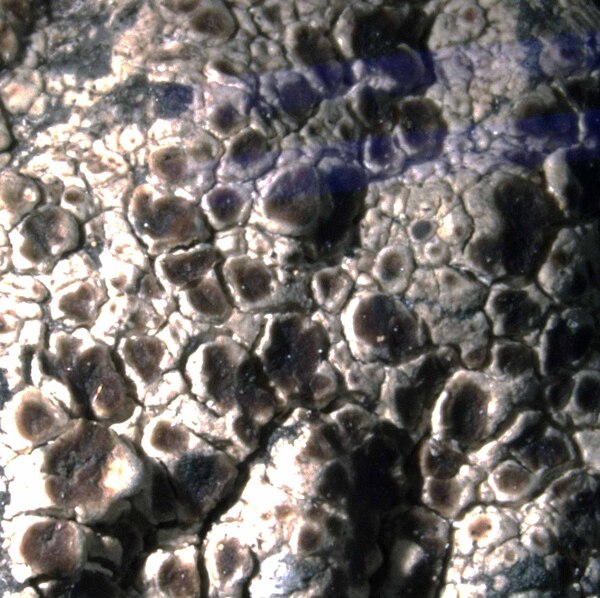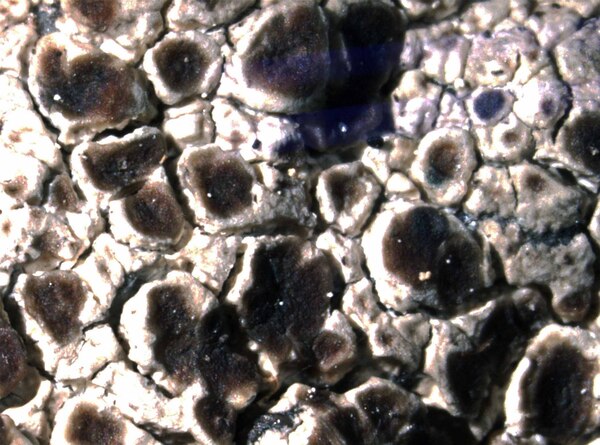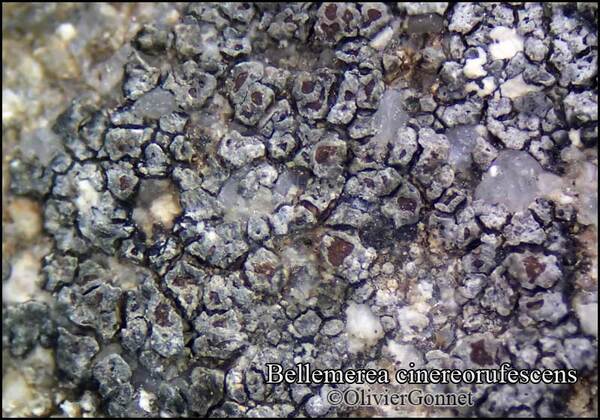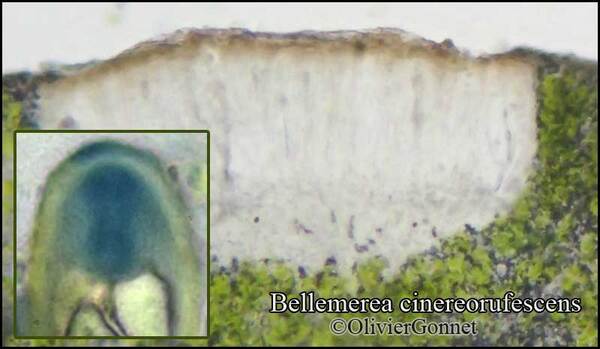Bellemerea cinereorufescens (Ach.) Clauzade & Cl. Roux
Bull. Soc. Bot. Centre-Ouest, n. sér. 15: 129, 1984. Basionym: Urceolaria cinereorufescens Ach. - Lichenogr. Univ.: 677, 1810.
Synonyms: Aspicilia cinereorufescens (Ach.) A. Massal.; Lecanora cinereorufescens (Ach.) Hepp
Distribution: N - Frl (TSB 3839), Ven, TAA (Nascimbene & al. 2022), Lomb (Ravera & al. 2024a), Piem (Ravera & al. 2024a), VA (Ravera & al. 2024a), Emil (Fariselli & al. 2020). C - Tosc (Ravera & al. 2024a).
Description: Thallus crustose, episubstratic rimose-areolate to verrucose, rather thick, pale to dark ash-grey, forming (1-)2-8 cm wide patches, often delimited by a black prothallus. Areoles 0.3-1.4(-2) mm wide, round or usually angular, flat to finally convex, contiguous or dispersed in the marginal parts. Cortex 10-20(-25) µm thick, the uppermost part brownish, sometimes covered with a very thin epinecral layer, without crystals; medulla white, I+ blue; algal layer extending below the hypothecium. Apothecia cryptolecanorine-aspicilioid, 0.3-1(-1.8) mm across, immersed in the areoles, 1-2(-3) per areole, with a concave to slightly convex, usually epruinose, dark brown to brown-black (when dry), or red-brown (when wet) disc, and a thin thalline margin. Proper exciple poorly developed, 10-15 µm thick, the uppermost cells brown, otherwise colourless; epithecium brown, N-; hymenium colourless, 60-100 µm high, I+ blue; paraphyses branched and anastomosing in upper part, 1.5-2.5(-3) µm thick at base, the apical cells to 3.5 µm wide, usually with a thin, dark brown cap; hypothecium colourless, 30-50 µm high, I+ blue. Asci 8-spored, clavate, approaching the Porpidia-type, with a less distinct tube structure. Ascospores 1-celled, hyaline, ellipsoid, (7-)8-16(-18) x (4-)5-9(-10) µm, the inner wall I+ blue, with a thin halonate epispore. Pycnidia dark, immersed. Conidia short-bacilliform, 4-5 x c. 1 µm. Photobiont chlorococcoid. Spot tests: thallus K-, C-, KC-, P-. Chemistry: without lichen substances.Note: a widespread holarctic, very variable species found on hard, often metal-rich siliceous rocks in upland areas; closely related to B. diamarta; records from Southern Italy, being very dubious (see Nimis 1993: 123) are not accepted here.
Growth form: Crustose
Substrata: rocks
Photobiont: green algae other than Trentepohlia
Reproductive strategy: mainly sexual
Species of metal-rich rocks
Commonnes-rarity: (info)
Alpine belt: rare
Subalpine belt: rare
Oromediterranean belt: absent
Montane belt: absent
Submediterranean belt: absent
Padanian area: absent
Humid submediterranean belt: absent
Humid mediterranean belt: absent
Dry mediterranean belt: absent

Predictive model
Herbarium samples
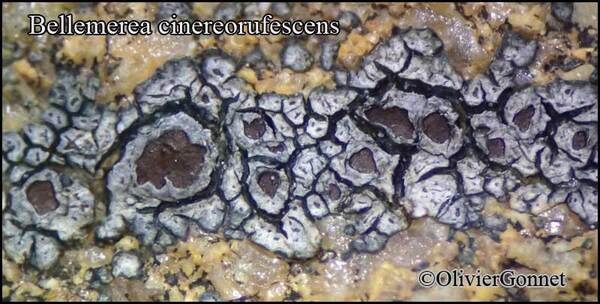
Courtesy: Olivier et Danièle Gonnet - Source: https://www.afl-lichenologie.fr/Photos_AFL/Photos_AFL_B/Textes_B2/Bellemerea_cinereorufescens.htm
France, Session AFL 2014 - Alpes de Haute-Provence
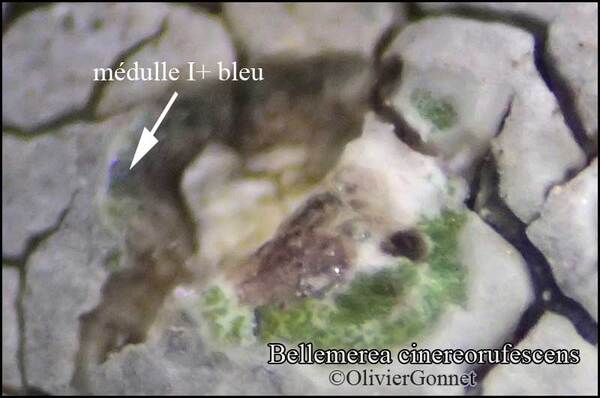
Courtesy: Olivier et Danièle Gonnet - Source: https://www.afl-lichenologie.fr/Photos_AFL/Photos_AFL_B/Textes_B2/Bellemerea_cinereorufescens.htm
France, Session AFL 2014 - Alpes de Haute-Provence
Growth form: Crustose
Substrata: rocks
Photobiont: green algae other than Trentepohlia
Reproductive strategy: mainly sexual
Species of metal-rich rocks
Commonnes-rarity: (info)
Alpine belt: rare
Subalpine belt: rare
Oromediterranean belt: absent
Montane belt: absent
Submediterranean belt: absent
Padanian area: absent
Humid submediterranean belt: absent
Humid mediterranean belt: absent
Dry mediterranean belt: absent

Predictive model
| Herbarium samples |

Courtesy: Olivier et Danièle Gonnet - Source: https://www.afl-lichenologie.fr/Photos_AFL/Photos_AFL_B/Textes_B2/Bellemerea_cinereorufescens.htm
France, Session AFL 2014 - Alpes de Haute-Provence

 Index Fungorum
Index Fungorum
 GBIF
GBIF
